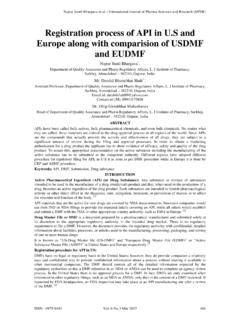Transcription of A REVIEW ON TEMPORARY RESTORATIVE …
1 Devika warrier E et al. / International Journal of Pharma Sciences and Research (IJPSR). A REVIEW ON TEMPORARY . RESTORATIVE MATERIALS. Devika warrier E* **. Saveetha Dental College and hospitals, Chennai,600077. ABSTRACT:- The aim of this REVIEW is to analyse the various TEMPORARY RESTORATIVE materials used in dentistry and its TEMPORARY restoration usually can be placed to seal a tooth until a permanent restoration can be TEMPORARY restoration seals the tooth, protecting the pulp from bacteria and reducing restorations are generally done when a tooth needs to be evaluated or time is not available for a final reason of this REVIEW is to know about TEMPORARY RESTORATIVE materials, their properties and usability in dentistry.
2 Keywords :- TEMPORARY Restoration,Dentistry. INTRODUCTION :- TEMPORARY RESTORATIVE materials are used for restoring the tooth temporarily until permanent restoration can be covers the prepared part of the tooth, in order to maintain the occlusal space as well as the contact points[1]. It also provide insulation of the pulpal tissues and maintains the periodontal relationship. Sometimes in order to prepare indirect restorations such as inlays and onlays,permanent restoration cannot be preferred after tooth restorations are also used for caries stabilization methods where many restorations are needed, and the problem may become worse before it can be fully treated.
3 Hence TEMPORARY restorations are placed in order to stop cariesprogression[2]. TEMPORARY restoration can last approximately for one month. Bacterial infection has been declared as the most common cause of the pulpal and periradicular diseases [3- 4]].Therefore; the major goals of root canal treatment are the chemo mechanical debridement and sealing of the root canal system to eliminate the restorations are commonly used to seal endodontic access cavities between patient visits and after completion of endodontic therapy to prevent coronal microleakage [5].
4 FUNCTIONS OF TEMPORARY RESTORATIVE MATERIALS :- 1-Provide an adequate seal against ingress of bacteria, fluids and organic materials from the oral cavity to the root-canal system. 2- Prevent seepage of intracanal medicaments 3- Adhere to tooth structure 4-It reproduces the tooth contours to allow ease of cleaning and also to maintain space. 5- Insulates the pulpal tissue and maintains the peridontal relationship IDEAL REQUIREMENTS OF TEMPORARY RESTORATIVE material :- The ideal requirements of a TEMPORARY filling materials are as follows :- 1. Should be easily removed from the cavity 2.
5 Should have sedative effect to the tooth and promote pulp healing 3. Reasonable strength and abrasive resistance 4. Radiopaque 5. Reasonable setting time and has low flow after setting 6. Anti bacterial property 7. Marginal integrity 8. Low Water sorption and solubility CLASSIFICATION OF TEMPORARY RESTORATIVE MATERIALS :- Based on composition :- 1) zinc oxide eugenol based materials 2) calcium sulfate- based materials 3) glass ionomer materials 4) composite resin based materials ISSN : 0975-9492 Vol. 7 No. 7 Jul 2016 315. Devika warrier E et al.
6 / International Journal of Pharma Sciences and Research (IJPSR). Throughout the dental history, a wide variety of materials have been used for TEMPORARY fillings. Although many materials are available, no material has been found that fulfils all or most of the properties for ideal TEMPORARY filling material . Given below is the brief description of materials that have been or are currently being used as TEMPORARY RESTORATIVE material . ZINC OXIDE EUGENOL BASED MATERIALS:- Eugenol-containing dental materials are frequently used in clinical dentistry.
7 When zinc oxide-eugenol (ZOE) is applied to a dentinal cavity, small quantities of eugenol diffuse through the dentin to the pulp. Low concentrations of eugenol exert anti-inflammatory and local anesthetic effects on the dental pulp. Thus use of ZOE TEMPORARY filling may facilitate pulpal healing; on the other hand, high eugenol concentrations are cytotoxic[6].Direct application of eugenol to pulp tissue may result in extensive tissue damage. The ability of ZOE-based endodontic sealers to influence periapical tissue healing is considered in view of eugenol's anti- inflammatory and toxic properties[7].
8 One of the most important property of this material is its sedative and the liquid provides an obtundent effect which help the pulp to relax after trauma from tooth preparation. COMPOSITION :- The chemical composition of ZOE is typically POWDER:- Zinc White Zinc (improves strength). Zinc (acts as accelerator). LIQUID :- eugenol-85wt%. olive oil:-15wt%. Modifications of zinc oxide eugenol based materials are IRM and EBA. INTERMEDIATE RESTORATIVE material :- IRM is a ZOE cement reinforced with polymethyl methacrylate. This reinforcement provides the restoration with improved compressive strength, abrasion,resistance and hardness[8].
9 The manufacturers recommend the use of IRM as a TEMPORARY restoration for cavities for up to 1 year using a powder to liquid ratio of 6 these recommendations usually results in a less than ideal seal but provides more optimum physical properties. The use of less powder provides a better seal at the expense of minimally compromising the physical properties[9].In addition, a softer mix exhibits greater antibacterialactivity due to hydrolysis and the subsequent increase in the release of eugenol, an antibacterial agent which may prevent bacterial colonization if leakage takes the leakage of IRM is increased when subjected to thermal stress, which was attributed to its dimensional instability[10].
10 EBA :- These are modifications ofzinc oxide eugenol based material whose main component is ethoxy benzoic acid, designed to produce a mechanical interlocking effect upon hardening inside the mouth. These cements usually consist of a basic powder (zinc oxide, aluminum oxide) and an acidic liquid (ethoxy benzoic acid) that are mixed together in a viscous paste immediately before use, setting to a hard mass. Ethoxy benzoic acid cements have proper thermal and chemical resistance in the oral environment[11].This material is resistant to dissolution, in oral fluids and non-irritating to pulp and gingiva.







